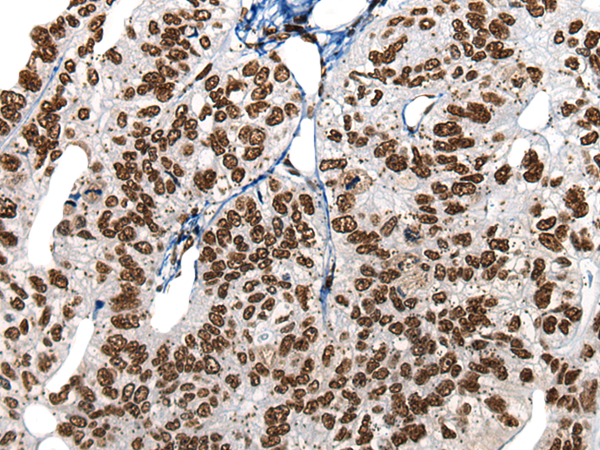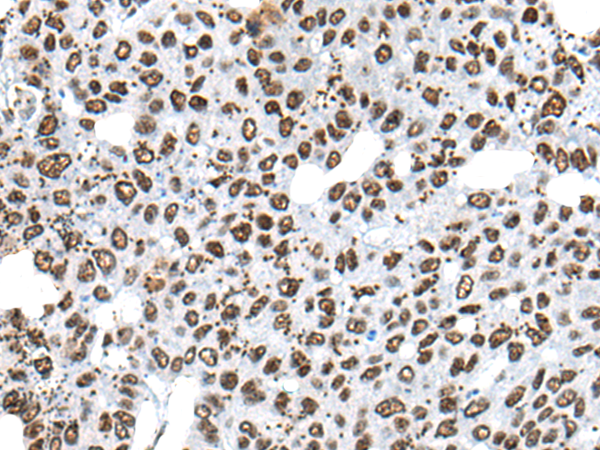

| WB | 咨询技术 | Human,Mouse,Rat |
| IF | 咨询技术 | Human,Mouse,Rat |
| IHC | 1/25-1/100 | Human,Mouse,Rat |
| ICC | 技术咨询 | Human,Mouse,Rat |
| FCM | 咨询技术 | Human,Mouse,Rat |
| Elisa | 1/5000-1/10000 | Human,Mouse,Rat |
| Aliases | HNRPR; hnRNP-R |
| Host/Isotype | Rabbit IgG |
| Antibody Type | Primary antibody |
| Storage | Store at 4°C short term. Aliquot and store at -20°C long term. Avoid freeze/thaw cycles. |
| Species Reactivity | Human |
| Immunogen | Synthetic peptide of human HNRNPR |
| Formulation | Purified antibody in PBS with 0.05% sodium azide and 50% glycerol. |
+ +
以下是关于HNRNPR抗体的参考文献示例(注:文献信息为示例性概括,具体内容建议通过学术数据库核实):
---
1. **"HNRNPR regulates the DNA damage response and genomic stability"**
*作者:Li et al. (2021)*
**摘要**:本研究利用HNRNPR特异性抗体进行免疫沉淀和蛋白质印迹实验,发现HNRNPR通过调控DNA修复相关基因的mRNA稳定性,影响细胞对DNA损伤的响应,缺失HNRNPR会导致基因组不稳定性增加。
2. **"HNRNPR mediates neuronal RNA splicing defects in ALS pathogenesis"**
*作者:Smith et al. (2019)*
**摘要**:通过免疫荧光和Western blot分析(使用HNRNPR抗体),作者发现肌萎缩侧索硬化症(ALS)患者神经元中HNRNPR异常聚集,导致RNA剪接失调,进而引发神经退行性病变。
3. **"HNRNPR promotes cancer metastasis by stabilizing EMT-related transcripts"**
*作者:Wang et al. (2020)*
**摘要**:研究采用HNRNPR抗体进行免疫组化和RNA免疫共沉淀(RIP),证明HNRNPR通过结合上皮-间质转化(EMT)相关mRNA并增强其稳定性,促进乳腺癌转移。
4. **"A systematic analysis of HNRNPR interactions in stress granule dynamics"**
*作者:Garcia-Moreno et al. (2018)*
**摘要**:利用HNRNPR抗体进行共聚焦显微镜观察和Co-IP实验,揭示HNRNPR在应激颗粒形成中的关键作用,其与TIA-1等蛋白的相互作用调控细胞应激反应。
---
**提示**:实际文献检索可通过PubMed或Google Scholar以关键词“HNRNPR antibody”或“HNRNPR immunohistochemistry”进行,并筛选涉及该抗体应用的实验研究。部分抗体厂商(如Abcam、CST)的产品说明页也可能提供相关参考文献。
The heterogeneous nuclear ribonucleoprotein R (HNRNPR) is a member of the hnRNP family, which plays critical roles in RNA metabolism, including splicing, transport, stability, and translation. HNRNPR contains RNA-binding domains (RRMs) and is involved in diverse cellular processes, such as mRNA processing, DNA repair, and stress response. Dysregulation of HNRNPR has been linked to neurological disorders (e.g., amyotrophic lateral sclerosis) and cancers, highlighting its functional importance.
HNRNPR antibodies are essential tools for studying its expression, localization, and interactions in cells. These antibodies are widely used in techniques like Western blotting, immunofluorescence, and immunoprecipitation to investigate HNRNPR's role in disease mechanisms or RNA-protein dynamics. Researchers also utilize them to explore post-translational modifications or altered expression patterns under stress or pathological conditions.
Commercially available HNRNPR antibodies are typically raised against specific epitopes, such as the N-terminal or RRM domains, and validated for species reactivity (human, mouse, rat). Challenges include ensuring specificity due to structural similarities among hnRNP family members. Recent studies emphasize the antibody's utility in identifying HNRNPR as a biomarker or therapeutic target, particularly in neurodegeneration and oncology. Proper validation using knockout controls remains crucial for reliable experimental outcomes.
×